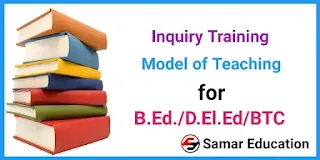Inquiry Training Model of teaching
Inquiry Training Model
The inquiry model, developed by Richard Suchman, is based on the premise that the intellectual strategies used by scientists to solve problems and inquire into the unknown, can be taught to students. Using the natural curiosity of students, they can be trained and disciplined in the procedures of inquiry. The model was developed from analysing the methods used in creative research personnel.
Process of Inquiry Training Model
The inquiry process will help students:
- To approach future problems with confidence in their abilities to seek out the solutions.
- To begin to consider success and failure as information rather than reward or punishment.
- Practice the process to develop the ability to sense the relevance of variables, make intuitive leaps, and put problems into forms with which they know how to work, and
- Improve their memory process because when they integrate material into their own cognitive structure thus, material is made more readily retrievable.
Basic elements of Inquiry Training Model
The inquiry training model has following goals:
1. The Focus
The model is specifically meant for developing mental powers which are used in research, inquiry or investigations. Suchman himself describes the objectives of this model as follows:
- (a) To develop the cognitive skills of searching and data-processing and the concepts of logic and causality necessary for inquiring autonomously and productively.
- (b) To give the learners a new approach to learning which is helpful in building concepts through the analysis of concrete episodes and the discovery of relationships between variables.
- (c) To capitalize on two intrinsic sources of motivation, the rewarding experience of discovery and the excitement that is inherent a autonomous searching and data processing.
Suchman's aim was to have a teaching strategy which should consist of activities which are mostly autonomously controlled and intrinsically rewarded (p. 28). The critical element in the model is to put the learners into a situation where they would have to try to find out the answer to a puzzling situation.
Thus, the focus of this model is to help the students develop an intellectual discipline and skills necessary to arise questions and search out answers stemming from curiosity. Inquiry training begins by presenting before the students a puzzling event. Suchman holds that faced with such a problem the students are naturally motivated to solve the puzzle.
2. Syntax
Syntax means the description of the model in action. The inquiry training model has five phases:
Phase 1: Encounter with the problem.
In this phase, the teacher presents a puzzling situation before the students and explains the inquiry procedures. Its aim is to create new knowledge. The initial inquiry is based on simple ideas.
Phase 2: Data Gathering & Verification
The students here try to collect detailed information about the problem. They try to seek clarifications about the doubts concerning the problem. Teacher virtually prepares the ground for the success of the model. The teacher should have an encouraging attitude. During verification, they can ask a question regarding the object, even property etc.
Phase 3: Data Gathering for Experimentation
This is a stage when the student actually starts putting questions and the teacher is reacting to their questions by saying yes or no as the case may be. This questioning by the student is continued till they are able to reach the stage where mystery could be solved.
Phase 4: Formulating and Explaining
In this the phase, the teacher will invite the pupils to explain things. Through explanation, rules may be formulated. The deviation is also checked so that efforts are applied in the right direction and no energy goes waste.
Phase 5: Analysis of the Inquiry Process
In this phase, the students analyze and reflect on the methods they adopted for inquiry. This helps in finding out a suitable solution to the various issues involved i.e the main problem, the right strategy for it etc.
Principle of Reaction
- Ensure that the phrasing of the 'yes' and 'no' questions is done correctly. There should be no double barrel questions.
- If the above is true, the teacher must ask the students to rephrase his or her question.
- Make sure that the other students take-off from questions already asked and that there should be no repetition. The teacher should also point out points which are not valid.
- Use the language of the inquiry process.
- In the process of the model the students will come up with hypotheses. The teacher must avoid evaluating the students' theories.
- Ask the students to make clear statements of theories and provide support for their generalization.
- Encourage interaction.
Social System
The teacher selects or designs the puzzling situation and presents it to the students. However, during the enquiry session teachers and students participate as equals. As the students learn the principles of inquiry, the teacher guides them to use the resource material and perform experiments and conduct discussion with other students. Once the students are trained in the principles of enquiry they are given freedom to select or design their own puzzling situations and play the game on their own or on their peer group.
Support System
All the specific conditions required for the smooth running of all phases of the model are called the support system. These would include books, films, posters and apparatus required for experimentation etc.


Join the conversation